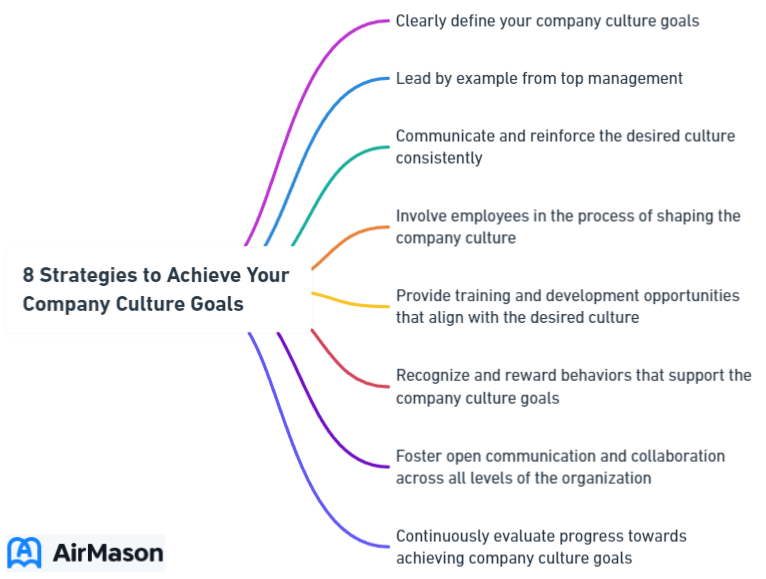
In today’s fast-paced business world, a strong company culture has become a crucial element for the long-term success of organizations. As leaders and employees alike recognize the importance of fostering a positive, inclusive, and high-performing work environment, company culture goals have taken center stage. But how can organizations achieve these goals in a way that drives employee engagement, nurtures diverse and inclusive teams, and ultimately, propels them towards success? The answer lies in understanding and implementing effective strategies that align with their unique culture and vision. Join us as we explore eight powerful strategies to achieve your company culture goals and unlock the potential of your team.
Key Takeaways
- Leadership plays a key role in defining and establishing company culture goals to create an inclusive workplace.
- Organizations should prioritize employee well-being, open communication, DEI initiatives and learning & development programs.
- Measure progress with KPIs and employee surveys to ensure continuous improvement of the work environment.
Understanding Company Culture Goals
Company culture goals play a pivotal role in shaping the overall work culture and driving an organization’s long-term success. Examples of company culture goals include initiating healthy habits, reinforcing and constructing new and existing relationships, and augmenting employees’ financial literacy. A strong team culture is critical to a company’s success, as it can create a positive work atmosphere and foster employee engagement. By examining company culture examples like Zoom, which values its personnel, organizations can gain valuable insights and motivation when constructing their business company culture. Understanding different team culture types can further enhance the effectiveness of these strategies.
The atmosphere of the company culture and the standards for employee interaction and collaboration are largely shaped by leadership. Leaders must give precedence to employee well-being to create a favorable work atmosphere and ensure employees are engaged and productive, thereby fostering a strong team culture. Open communication, wherein employees feel at ease expressing themselves and their viewpoints, ultimately contributes to a strong company culture.

Defining Company Culture Goals
Company culture goals are the desired outcomes of an organization’s efforts to create a positive, inclusive, and productive work environment that aligns with its values and mission. These goals can be established by leadership, who play an integral role in setting the tone for the organization and modeling desired behaviors. The company culture’s atmosphere and the standards for employee interaction and collaboration are significantly influenced by leadership, shaping the organizational culture and corporate culture.
Employee well-being is critical for establishing a favorable work atmosphere and guaranteeing that employees are involved and fruitful, contributing to a strong team culture. Open communication could be facilitated by establishing a workplace atmosphere wherein employees feel at ease expressing themselves and their viewpoints, ultimately contributing to a strong company culture.
Implementing DEI programs can facilitate the formation of a more diverse and inclusive work environment, which can result in heightened innovation and creativity. Measuring the effectiveness of DEI initiatives can be determined by monitoring key performance indicators (KPIs) and administering employee surveys.
The Role of Leadership in Establishing Culture Goals
Leadership plays a significant role in establishing and promoting company culture goals, setting the tone for the organization and exemplifying desired behaviors. Senior leaders and management are essential in fostering a positive team culture.
In the words of Michael Bevilacqua, the most effective approach to fostering a high performing team culture of high-performance, rapid-paced, and creative thinking is through modeling behavior. Evaluating the existing leadership style is imperative if there are any detrimental characteristics that affect employees or impede the organization from attaining the desired type of culture, such as a team culture.
Understanding an Organization’s Culture
An organization’s culture is the collective personality and identity that shapes its work environment. It encompasses shared values, beliefs, and behaviors that define how members interact and work together towards common goals. This culture permeates every aspect of the organization, from its mission statement to the way decisions are made and employees are recognized. An organization’s culture plays a crucial role in attracting and retaining talent, as it sets the tone for the type of individuals who will thrive within its ecosystem. Furthermore, it influences how conflicts are resolved, innovation is fostered, and ultimately, how the organization adapts to change and external challenges. Therefore, understanding and nurturing a positive, inclusive, and adaptive organizational culture is essential for long-term success and sustainability.
Fostering a Positive Work Environment

A positive work environment is pivotal for the well-being and productivity of employees. A crucial aspect of fostering such an environment is prioritizing employee well-being, dedicating each month to a different aspect, such as healthy habits, building friendships, and financial know-how.
Establishing open communication across teams and experience levels has created an inclusive culture in which all individuals feel comfortable posing difficult questions and collaborating to tackle challenges.
Importance of Employee Well-being
A prosperous work environment is contingent upon employee well-being. Organizations can support mental health amongst employees by:
- Training managers to promote health and well-being
- Increasing employees’ options for work
- Encouraging physical and emotional health
- Providing mental wellness resources
- Promoting flexibility in schedules
- Offering access to apps for sleep and stress reduction
- Raising awareness about mental health
- Developing holistic employee mental health resources.
Prioritizing employee well-being not only enhances the work atmosphere but also guarantees that employees are engaged and fruitful, contributing to a strong team culture.
Encouraging Open Communication
Trust, collaboration, and innovation among employees are fostered by open communication. Organizations should motivate their employees to express their ideas, feedback, and concerns, thereby creating an environment that fosters open communication and collaboration.
Establishing a workplace atmosphere wherein employees feel at ease expressing themselves and their viewpoints ultimately contributes to a strong company culture and fosters a positive culture.
Creating a Positive Work Environment
Creating a positive work environment is crucial for fostering productivity, boosting employee morale, and ultimately driving the success of any organization. It starts with open communication and a culture of respect among team members. Encouraging collaboration and recognizing individual contributions can go a long way in making employees feel valued and motivated. Moreover, providing opportunities for skill development and growth can lead to a sense of fulfillment and commitment among staff. Additionally, initiatives that promote work-life balance and mental well-being are equally vital in maintaining a positive workplace atmosphere. By prioritizing these elements, organizations can cultivate a work environment where employees thrive and contribute their best efforts.
Prioritizing Diversity, Equity, and Inclusion (DEI)

Constructing a workforce that is both inclusive and diverse necessitates the prioritization of DEI. By implementing DEI programs, organizations can create a more diverse and inclusive work environment. Some examples of DEI programs include:
- Diverse hiring practices
- Promoting pay equity
- Mentorship for underrepresented groups
- Talent development
These programs can result in heightened innovation and creativity.
Implementing DEI Programs
DEI programs often comprise training, mentorship, and employee resource groups, and should be tailored to meet the organization’s particular needs and objectives. Notable examples of successful DEI programs in companies include Sodexo, Johnson & Johnson, Mastercard, Accenture, Kaiser Permanente, EY, Cisco, and Marriott International. These companies have implemented various initiatives, such as diverse hiring practices, promoting pay equity, mentorship for underrepresented groups, and talent development.
To implement DEI programs in a startup, one may follow these strategies:
- Clearly articulate the company’s stance on DEI to all employees.
- Undertake a culture assessment to understand the current state of diversity, equity, and inclusion in the organization.
- Align DEI initiatives with organizational goals.
- Take into account invisible factors that may influence diversity and inclusion.
- Be transparent about DEI efforts and progress.
- Demonstrate a genuine and sustained commitment to employees.
- Put the DEI policy in writing, including a clear statement of the company’s commitment to diversity, equity, and inclusion.
- Set targets for diversity and inclusion and assign someone to be responsible for achieving them.
Measuring the Success of DEI Initiatives
Assessment of the efficacy of DEI initiatives may involve monitoring metrics such as employee demographics, retention rates, and promotion rates, as well as collecting qualitative feedback from employees to evaluate employee performance.
When evaluating the success of DEI initiatives, it is essential to consider metrics such as:
- Attrition rate
- Performance metrics
- Promotion rates
- Leadership pipeline diversity
- Employment pipeline diversity
- Pay equity
- Dollars allocated to DEI
- Number of diverse employees across the organization
- Percentage of diverse employees in leadership positions
Monitoring retention rates allows organizations to gauge the effect of their DEI initiatives and make the necessary modifications to ensure long-term success.
Investing in Learning and Development

In a people-first culture, learning and development are crucial as they augment the efficiency of employees for their own benefit and the company’s. Providing employees with opportunities to develop their capabilities can significantly contribute to employee growth and organizational success. Some ways to do this include:
- Sending them to conferences
- Furnishing them with high-spec laptops
- Allotting time for working on passion projects
- Arranging knowledge-sharing sessions
- Organizing team activities
Developing Employee Skills
The development of employee skills requires the provision of training programs, workshops, and opportunities for cross-functional collaboration, enabling employees to acquire new skills and knowledge. Organizations can promote employee skill development by providing training programs, workshops, and opportunities for cross-functional collaboration.
Employee mentorship programs, where employees are paired up with relevant mentors who provide advice and guidance, can be instrumental in facilitating opportunities for growth and development. Research indicates that having a mentor improves employees’ chances of promotion. In fact, they are five times more likely to be promoted than their peers without mentors.
Supporting Career Growth
Career growth facilitation may include the offering of mentorship, career pathing, and opportunities for advancement within the organization. At Bluecore, we begin career pathing during the recruitment process and continue it throughout the employee’s tenure. Senior leaders provide career coaching and guidance to assist team members in exploring their interests and identifying roles within the company that allow them to capitalize on their distinct abilities — even if that necessitates creating a new role.
Mentorship facilitates career growth by imparting guidance, support, and accountability. Mentors aid in honing communication skills, broadening professional networks, and defining and setting goals. Additionally, mentors bolster confidence, leadership abilities, and interpersonal skills, all of which are pivotal to career progression. Mentoring programs are advantageous to both mentees and mentors, as they promote personal and professional growth.
Building Culture at Work
Building a strong and positive culture at work is paramount for fostering a thriving and productive environment. It goes beyond superficial perks and extends into the core values and beliefs that define an organization. When intentional steps are taken to cultivate a culture that empowers employees, encourages collaboration, and celebrates diversity, it can lead to higher employee engagement and satisfaction. This, in turn, often translates to increased productivity and retention rates. Moreover, a well-defined work culture can act as a guiding force, aligning the team towards common goals and objectives. It sets the tone for how individuals interact, communicate, and approach their tasks, ultimately shaping the overall identity and reputation of the organization.
Enhancing Employee Engagement

Organizational success hinges on enhancing employee engagement, which aids in creating a positive work atmosphere, fostering open communication, and nurturing a sense of belonging and inclusion. Building strong connections and recognizing and rewarding achievements are key pillars of engagement that contribute to a thriving workplace culture.
Building Strong Connections
Organizations can promote strong connections and positive team cultures through the implementation of team-building activities, regular check-ins, and the cultivation of a sense of belonging among employees. Team-building activities and regular check-ins can help cultivate a positive team atmosphere and foster strong connections as employees get to know one another better.
Effective team-building activities for remote employees may include:
- Virtual scavenger hunts
- Online team trivia or quiz games
- Virtual escape rooms
- Virtual happy hours or coffee breaks
- Online team-building workshops or training sessions
- Virtual team-building games or challenges
- Collaborative online projects or tasks
- Virtual team-building exercises or icebreakers.
Recognizing and Rewarding Achievements
Appropriately recognizing and rewarding achievements may involve providing commendations, career advancement opportunities, and rewards for personnel who demonstrate the company ethos and contribute to its prosperity. During Zoom’s company-wide office meeting, employees acknowledge a colleague who provided assistance and present updates to keep everyone informed and demonstrate gratitude for individual accomplishments.
Paxos fosters employee engagement by participating in community volunteering initiatives, commemorating employee birthdays and work anniversaries, and organizing events such as a Guacamole-Off.
Aligning Recruitment and Onboarding Processes

The synchronization of recruitment and onboarding processes with company culture goals is vital for attracting and retaining high-caliber personnel. By ensuring a successful alignment with company mission and culture during the recruitment and hiring phase, organizations can attract and retain top talent that contributes to the overall success of the company.
Hiring for Cultural Fit
To hire for cultural fit, the values, attitudes, and behaviors of candidates need to be assessed to ensure alignment with the organization’s culture and goals. Recruiters can assess cultural fit during the hiring process by:
- Defining and articulating the organization’s culture
- Reviewing the candidate’s work background
- Utilizing interview questions to gauge fit
- Involving the team
- Being cognizant of personal biases
- Observing candidates’ reactions
However, it is crucial to be aware of the potential disadvantages of hiring for cultural fit, such as:
- an homogeneous workforce
- low employee retention rates
- the reinforcement of biases
- an absence of rigor in the hiring process.
Effective Onboarding Programs
Onboarding programs serve as a process that eases the integration of new hires into the company culture and equips them to perform their roles optimally. It usually consists of orientation sessions, mentorship, and continued assistance. Effective onboarding programs can include instant goal setting, welcome kits, company-wide announcements, interactive courses, welcome gifts, engaging policy training, pairing new hires with an onboarding buddy, sending company swag, and organizing team lunches and social events. These programs play a crucial role in enhancing employee engagement, augmenting job satisfaction, improving job performance, and increasing retention rates.
Measuring and Monitoring Company Culture Progress

Continuous improvement and the maintenance of a thriving work environment necessitate the measurement and monitoring of company culture progress. Organizations can track their progress by using key performance indicators (KPIs) and conducting employee surveys that provide valuable insights into the health and effectiveness of the company’s culture.
Key Performance Indicators (KPIs)
KPIs in the context of company culture are quantifiable metrics that organizations track to measure and improve aspects of their culture. Some examples of KPIs for company culture include:
- Employee satisfaction surveys
- Program and event metrics
- Anecdotes
- HR/workforce metrics
- Other indicators that provide insights into the health and effectiveness of the company’s culture.
These KPIs help organizations understand how their culture, aligned with core values, is performing and identify areas for improvement.
Regularly reviewing and adjusting KPIs, at least once a month, every quarter, and every year, is crucial to make sure you sustain a positive company culture.
Conducting Employee Surveys
Employee surveys can provide substantial insights into employees’ perceptions of the company culture, identify areas in need of improvement, and track progress over time. To ensure anonymity in employee surveys, organizations should:
- Maintain privacy of personally identifiable information
- Utilize anonymous survey platforms
- Assure employees that their responses will remain confidential
- Avoid questions that could potentially reveal the identity of the respondent
- Employ aggregated reporting to present survey results.
Questions for employee surveys can include topics related to:
- Job satisfaction
- Company culture
- Support from colleagues and supervisors
- Resources and tools necessary for job effectiveness
- Opportunities for learning and growth.
Summary
In conclusion, achieving company culture goals is crucial for creating a positive, inclusive, and high-performing work environment that drives organizational success. By understanding the importance of company culture goals, fostering a positive work environment, prioritizing diversity, equity, and inclusion, investing in learning and development, enhancing employee engagement, aligning recruitment and onboarding processes, and measuring and monitoring company culture progress, organizations can unlock the potential of their teams and propel their companies forward. It’s time to take action and embrace the power of company culture goals to shape a thriving organization.
Frequently Asked Questions
What are cultural goals examples?
Cultural goals are important aspects for any business to strive for, such as improving diversity, equity and inclusion, retaining employees from underrepresented demographics, fostering an innovative mindset, investing in personal education, promoting collaboration and teamwork, and increasing involvement in the local community.
What are the goals of people and culture?
The goals of People and Culture teams are to help achieve organizational objectives, set workplace standards, manage conflicts, and ensure everyone in the organization feels valued and included. These measures can lead to improved DEI, retention of underrepresented employees, and greater overall business success.
What is an example of a culture statement?
An example of a culture statement is Gable’s commitment to diversity, curiosity, caring for customers and team members, mission-driven goals, customer focus and agility while also promoting inclusivity and empowerment.
What are smart goals in team culture?
SMART goals are an effective way to create a culture of clear and reachable objectives that are Specific, Measurable, Achievable, Relevant, and Timely. They can boost employee productivity, foster development, and improve feedback systems to ensure success.
How can organizations foster a positive work environment?
Organizations can prioritize employee well-being, dedicate each month to different aspects of it, and encourage open communication to foster a positive work environment.